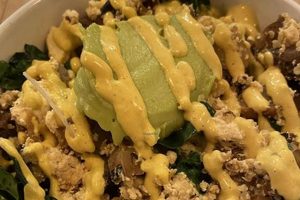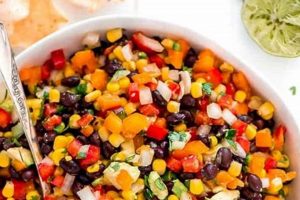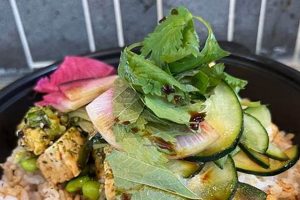The question of whether a colorant used in food products aligns with vegan principles often arises. These substances, added to impart visual appeal to edibles and beverages, may or may not be derived from animal sources. Therefore, scrutiny of their origin and manufacturing processes is essential to determine their suitability for those adhering to a plant-based diet.
The significance of understanding the source of these additives stems from the ethical considerations inherent in veganism. Individuals following this lifestyle aim to avoid all forms of animal exploitation and cruelty. Knowing the origin of a color additive ensures alignment with these values. Historically, some coloring agents were derived from insects or animal byproducts, highlighting the need for diligent investigation of ingredient lists.
Consequently, the following sections will delve into common colorants, their potential sources, and methods for identifying those that are definitively plant-derived versus those that may pose concerns for individuals adhering to a vegan lifestyle. This information will empower informed choices when selecting food and beverage products.
Guidance on Color Additives and Vegan Dietary Choices
The following guidelines assist in navigating the complexities of color additives and their compatibility with a vegan dietary regimen. Scrutiny of product labeling and awareness of common sources are critical.
Tip 1: Meticulously examine ingredient lists on all packaged goods. Look for specific color additive names (e.g., Red 40, Blue 1) and research their origins independently if uncertainty exists.
Tip 2: Prioritize products certified as vegan by reputable organizations. Such certifications typically involve a thorough review of all ingredients and manufacturing processes.
Tip 3: Be aware that natural color additives are not automatically vegan. Carmine, derived from insects, is a natural red dye that is not suitable for vegan consumption.
Tip 4: Contact the manufacturer directly if ingredient information is unclear or ambiguous. Direct communication can clarify the source and processing of color additives.
Tip 5: Consult reliable online databases and resources that provide detailed information about the vegan status of various food additives, including colorants. Examples include vegan society websites and ingredient analysis tools.
Tip 6: Exercise caution when dining out. Inquire about the ingredients used in dishes, particularly sauces and desserts, as color additives are often incorporated.
These guidelines, when diligently applied, empower individuals to make informed purchasing decisions that align with their commitment to a vegan lifestyle. Awareness and proactive investigation are essential for ensuring the absence of animal-derived substances in consumed products.
Subsequent sections will explore specific color additives of concern and provide further strategies for navigating the food industry’s labeling practices.
1. Source Material
The origin of a food coloring is paramount in determining its suitability for a vegan diet. Certain colorants are derived directly from animal sources, rendering them incompatible with vegan principles. Carmine, also known as cochineal extract, serves as a definitive example. This red dye is extracted from the crushed bodies of female cochineal insects. Consequently, any food product listing carmine as an ingredient is, by definition, non-vegan. Conversely, colorants sourced from plants, such as beta-carotene (often derived from carrots) or anthocyanins (found in berries), are generally considered vegan-friendly, provided no animal-derived processing aids are used in their extraction or formulation.
The importance of source material extends beyond the immediate ethical consideration of animal exploitation. Understanding the source also aids in identifying potential allergens or other unwanted substances. For instance, a person with allergies to certain plants may need to avoid colorings derived from those plants. The food industry’s increasing trend toward natural colorants necessitates vigilance. While the term “natural” may seem appealing, it does not guarantee vegan status. Turmeric oleoresin, derived from the turmeric root, is another instance of a natural and vegan colorant. Conversely, shellac, derived from insects, is also “natural” but not vegan. Therefore, relying solely on the term “natural” is insufficient for verifying vegan compliance.
In summary, the source material is the foundational element in ascertaining whether a food coloring is vegan. Rigorous investigation, exceeding simple ingredient list scans, is vital. Consumers must actively seek details regarding the specific origin of each colorant, considering potential animal-derived sources or processing aids. By prioritizing transparently labeled products and familiarizing themselves with common animal-derived colorants, individuals adhering to vegan principles can make informed and ethical dietary choices.
2. Animal Derivatives
The presence of animal derivatives directly contradicts the vegan ethos, thus playing a crucial role in the determination of whether a food coloring is vegan. The introduction of substances sourced from animals, whether as direct ingredients or processing aids, renders the final product unsuitable for vegan consumption. This principle hinges on the core tenet of veganism, which seeks to minimize animal exploitation in all aspects of life, including dietary choices. The impact of animal derivatives can be subtle, extending beyond obvious ingredients like carmine (derived from insects). Examples include the use of bone char in the processing of certain sugars, which subsequently may be used in the production of a colorant carrier. If this sugar is used, the colorant would no longer be considered vegan.
The practical significance of understanding this connection lies in the need for vigilant scrutiny of ingredient lists and manufacturing processes. Consumers cannot solely rely on the perceived “naturalness” of a colorant or the absence of explicitly animal-derived ingredients in the final product. The manufacturing process, including the use of clarifying agents, filtering media, and other processing aids, must be thoroughly investigated. Furthermore, the origin of seemingly benign ingredients, such as “natural flavors” or “carriers,” should be questioned, as these can sometimes mask the presence of animal derivatives. The food industry’s labeling practices do not always offer complete transparency, necessitating direct communication with manufacturers to confirm the absence of animal derivatives in all stages of production.
In conclusion, the potential presence of animal derivatives is a primary determinant of vegan status regarding food colorings. Awareness of these hidden sources and the proactive pursuit of comprehensive ingredient information are essential for upholding ethical vegan dietary practices. Challenges persist due to incomplete labeling and complex manufacturing processes; however, increased consumer demand for transparency and vegan-certified products can drive industry-wide improvements in the disclosure of animal-derived substances. The investigation of animal derivatives is integral to verifying whether a food coloring meets the standards of a vegan lifestyle.
3. Manufacturing Processes
The alignment of manufacturing processes with vegan principles significantly influences the determination of whether a food coloring is vegan. Even when the source material appears plant-based, the methods used in its extraction, purification, and formulation can introduce animal-derived substances, rendering the final product non-vegan. One instance involves the utilization of bone char, a material derived from animal bones, in the decolorization of sugar. This sugar is often a component in carrier systems for powdered or liquid colorings. While the coloring itself may be synthetically produced or extracted from plants, the bone char filtration process introduces an animal-derived element, thereby precluding its acceptance within a vegan dietary framework. Therefore, the manufacturing process is not merely a secondary consideration but a critical factor in assessing the vegan status of a food coloring.
Another area of concern is the employment of animal-derived enzymes or fining agents during the processing of “natural” colorings extracted from plant sources. Gelatin, derived from animal collagen, may be used to clarify or stabilize certain liquid color preparations. Similarly, isinglass, a substance obtained from fish bladders, could be employed to remove turbidity or unwanted particles from color extracts. These applications, though not readily apparent in the final ingredient list, introduce animal products into the manufacturing stream, thereby compromising the vegan integrity of the coloring. The practical impact of this understanding is that consumers must extend their scrutiny beyond the listed ingredients to encompass the entire production chain. This can be achieved through direct communication with manufacturers, requesting detailed information about their processing methods and the sources of all materials used.
In conclusion, the manufacturing processes involved in producing food colorings represent a critical but often overlooked aspect of determining their vegan status. The potential for animal-derived substances to be introduced as processing aids, even when the primary source material is plant-based or synthetic, necessitates rigorous investigation. Challenges arise from the complexity of modern food production and the lack of complete transparency in labeling practices. However, awareness of these issues and a proactive approach to seeking information can empower consumers to make informed choices that align with their ethical commitments to a vegan lifestyle. The process is therefore an inherent part of the is food coloring vegan query.
4. Labeling Accuracy
The precision of product labeling assumes paramount importance when determining whether a food coloring is vegan. Deficiencies in labeling can obscure the presence of animal-derived substances, undermining the efforts of individuals adhering to plant-based diets to make informed purchasing decisions.
- Specificity of Ingredient Descriptions
Vague ingredient descriptions, such as “natural color” or “artificial color,” offer insufficient information to ascertain the origin of the colorant. Carmine, derived from insects, can be deceptively listed simply as “natural red color.” Similarly, the term “artificial color” provides no indication of whether the colorant was produced using animal-derived processing aids. Accurate labeling necessitates the explicit identification of each colorant by its common name (e.g., carmine, annatto) or its assigned number (e.g., Red 40, Yellow 5), allowing consumers to conduct independent research and verify its vegan status.
- Transparency Regarding Processing Aids
Labeling regulations often do not mandate the disclosure of processing aids, even if those aids are derived from animal sources. This omission creates a significant challenge for vegans. For instance, bone char filtration, employed to decolorize sugar, may leave no trace of animal products in the final sugar itself. However, if this sugar is subsequently used in the production of a food coloring, the final product may not align with vegan principles. Complete transparency would require manufacturers to declare the use of all processing aids, regardless of their presence in the finished product, enabling informed decisions based on the entire production process.
- Cross-Contamination Warnings
While not directly related to the ingredients themselves, the absence of adequate cross-contamination warnings can also mislead consumers. A food coloring produced in a facility that also handles animal products may be subject to cross-contamination, raising concerns for strict vegans. Clear and prominent cross-contamination warnings are essential for enabling individuals to assess the potential risks and make purchasing decisions accordingly.
- Certification Clarity
Vegan certification logos offer a valuable tool for consumers seeking assurance that a product aligns with their dietary principles. However, the absence of a certification logo does not automatically indicate that a product is non-vegan. Conversely, the presence of a fraudulent or misleading certification logo can lead consumers to make incorrect assumptions. Therefore, it is crucial to verify the authenticity and credibility of any certification claim before relying on it as a basis for purchasing decisions.
In conclusion, accurate and comprehensive labeling is essential for empowering vegans to make informed choices regarding food colorings. The lack of specificity, transparency, and appropriate warnings can obscure the presence of animal-derived substances or processes, undermining the efforts of individuals seeking to adhere to a plant-based diet. Enhanced labeling regulations and increased manufacturer accountability are necessary to ensure that consumers have access to the information they need to align their purchasing decisions with their ethical values.
5. Certification Status
Certification status represents a critical validation mechanism for assessing whether a food coloring aligns with vegan principles. Independent certification by recognized organizations provides assurance that a thorough evaluation of the colorant’s source, manufacturing processes, and potential for cross-contamination has been conducted, thus minimizing reliance solely on product labeling.
- Third-Party Verification
Vegan certification involves rigorous audits by third-party organizations. These entities assess every stage of production to confirm adherence to strict vegan standards. This includes verifying the absence of animal-derived ingredients, processing aids, and potential cross-contamination. Certification marks, such as the Vegan Action logo or the Vegan Society logo, signify that a food coloring has undergone this independent review, offering a higher level of confidence.
- Supply Chain Transparency
Certification processes require manufacturers to provide detailed information about their supply chains. This traceability helps to identify potential sources of animal-derived materials that may not be apparent from the final product ingredients list. The assessment includes examining the origins of raw materials, the methods used for extraction and purification, and the controls in place to prevent contamination. By evaluating the entire supply chain, certification bodies can ensure that the food coloring meets vegan standards from start to finish.
- Regular Audits and Monitoring
Vegan certification is not a one-time assessment. Certified products are subject to regular audits and monitoring to ensure ongoing compliance with vegan standards. This ongoing oversight helps to maintain the integrity of the certification and provides assurance that the food coloring continues to meet the requirements for vegan status. Failure to maintain compliance can result in the revocation of certification, underscoring the importance of regular audits.
- Consumer Confidence
Certification status directly enhances consumer confidence in the vegan integrity of a food coloring. The presence of a recognized vegan certification logo provides a clear and easily identifiable signal that the product has been independently verified to meet vegan standards. This is particularly important for individuals who prioritize ethical consumption and seek to avoid products that may have involved animal exploitation or cruelty. The visual cue of a certification mark can simplify the purchasing decision and reduce the need for extensive individual research.
The certification status is pivotal for those questioning “is food coloring vegan”. Certification provides a robust, independently verified confirmation, addressing concerns that may arise from incomplete labeling or opaque manufacturing processes. However, the absence of certification should not be interpreted as conclusive evidence that a food coloring is non-vegan; further investigation may be required. Ultimately, certification serves as a valuable tool for consumers seeking assurance and simplifying their pursuit of vegan-compliant products.
Frequently Asked Questions
The following addresses common inquiries regarding the compatibility of food colorings with vegan dietary standards. The information provided aims to clarify uncertainties and promote informed consumption.
Question 1: Are all “natural” food colorings vegan?
No, the term “natural” does not guarantee vegan status. Carmine, derived from insects, is a natural red dye that is not vegan. Shellac, also from insects, is “natural” but not vegan. Always verify the source.
Question 2: How can hidden animal derivatives in food colorings be identified?
Scrutinize ingredient lists, paying attention to vague terms like “natural flavors” or “artificial colors,” then contact manufacturers directly for specific details about the colorant’s origin and processing.
Question 3: Is vegan certification a reliable indicator of a food coloring’s suitability?
Yes, certification from reputable vegan organizations involves rigorous audits and provides a high level of confidence. Verify the certifying organization’s credibility.
Question 4: Are synthetic food colorings always vegan?
Generally, synthetic colorings are vegan, as they are chemically produced. However, the manufacturing process should be checked for animal-derived processing aids.
Question 5: What are some common non-vegan food colorings to avoid?
Carmine (cochineal extract), derived from insects, is a primary example. Less common are instances where animal-derived processing aids are used during color extraction or production.
Question 6: If a product doesn’t explicitly state “vegan,” is it automatically non-vegan?
Not necessarily. The absence of a “vegan” label does not automatically indicate that a product is unsuitable. A thorough examination of ingredients and manufacturing processes is necessary to determine its vegan status.
In summary, determining whether a food coloring aligns with vegan principles requires diligence. Reliance on certification, direct manufacturer inquiry, and critical ingredient assessment are essential for informed choices.
The following section will further explore specific examples of food colorings, providing a deeper understanding of their sources and potential concerns for vegan consumers.
Conclusion
This exploration of “is food coloring vegan” has revealed a complex landscape requiring diligence from consumers. Determining suitability necessitates scrutinizing the source, manufacturing processes, and labeling accuracy. Reliance solely on terms like “natural” proves insufficient. Independent vegan certification offers the most reliable assurance, though its absence demands further investigation. The potential for hidden animal derivatives necessitates proactive inquiry, emphasizing the importance of manufacturer transparency.
The onus remains on the consumer to navigate these complexities. As awareness grows, increased demand for transparent labeling and vegan-certified options may drive industry-wide change. Upholding ethical consumption requires continued vigilance and a commitment to informed choices, ensuring food selections align with vegan values and minimize unintentional participation in animal exploitation.







